One of the most important factors in towing is making sure that your trailer hitch is at the correct height. If it’s too high, your trailer will be tilted upwards, which can lead to problems with stability and handling.
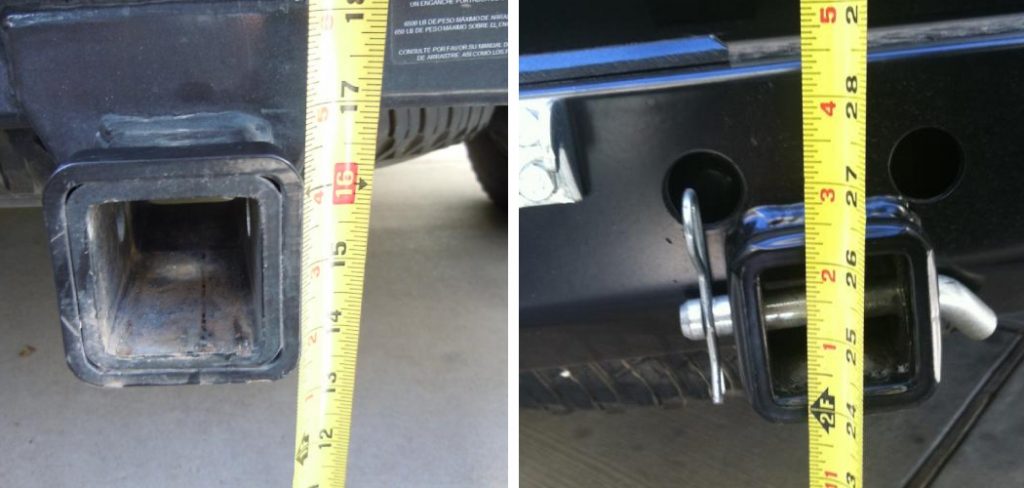
On the other hand, if it’s too low, you risk scraping or damaging the bottom of your trailer. In this guide, we’ll show you how to measure drop hitch and ensure that your towing experience is safe and smooth.
Necessary Items
To measure your drop hitch, you’ll need the following items:
- Tape measure
- Leveling tool (can be a carpenter’s level or smartphone app)
- Trailer tongue weight scale (optional but recommended)
- Drop hitch receiver
12 Steps on How to Measure Drop Hitch
Step 1: Park Your Vehicle and Trailer on Level Ground
Before attempting to measure your drop hitch, make sure that both your vehicle and trailer are parked on a flat, level surface. This will ensure accurate measurements. If you don’t have access to a level surface, you can use the leveling tool to compensate for any uneven ground.
Step 2: Measure the Height of Your Vehicle’s Hitch Receiver
Using your tape measure, find the height of your vehicle’s hitch receiver. This is where the drop hitch will be inserted. While most hitch receivers are at a standard height of 18 inches, it’s always best to double-check.
Step 3: Measure the Height of Your Trailer’s Coupler
Next, measure the height of your trailer’s coupler. This is where the drop hitch receiver will connect to your trailer. Like the hitch receiver, this measurement can vary, so be sure to check before making any adjustments.
Step 4: Measure the Difference Between the Two Heights
Subtract the height of your vehicle’s hitch receiver from the height of your trailer’s coupler. This will give you the difference in height between the two, which is also known as “drop.” So if your hitch receiver measures 18 inches and your trailer’s coupler measures 24 inches, the drop is 6 inches.
Step 5: Calculate Your Vehicle’s Tongue Weight
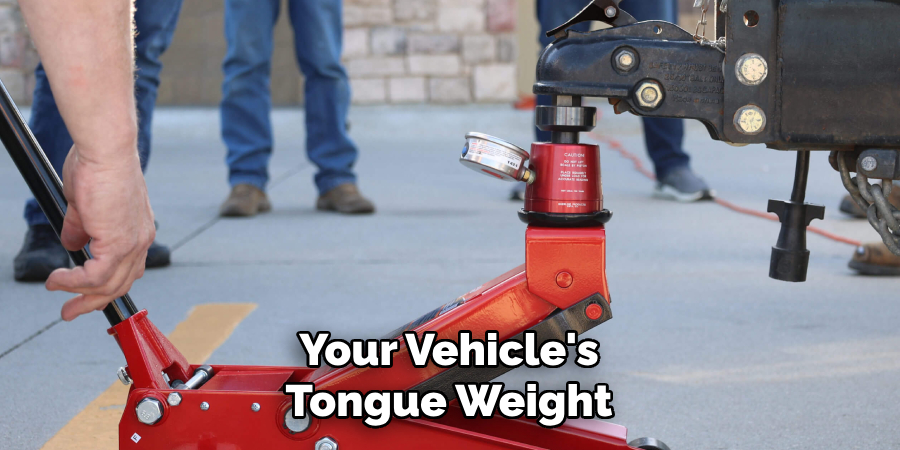
Your vehicle’s tongue weight is the amount of weight that your trailer puts on the hitch when it’s connected. This weight should never exceed the maximum towing capacity of your vehicle. To calculate your tongue weight, you can use a trailer tongue weight scale or refer to your vehicle’s manual for the maximum allowed weight.
Step 6: Add the Tongue Weight to the Difference in Height
Take the tongue weight and add it to the difference in height that you calculated in Step 4. This will give you the total amount of drop that your drop hitch needs to have. And remember, always choose a drop hitch with a higher weight capacity than your tongue weight to ensure safe towing.
Step 7: Choose Your Desired Drop Hitch
Based on the total amount of drop needed, you can now choose the appropriate drop hitch receiver. These come in various sizes and capacities, so make sure to select one that fits your needs. But remember, it’s always better to have a little too much drop than not enough.
Step 8: Insert the Drop Hitch Into the Hitch Receiver
Now that you have your drop hitch receiver insert it into your vehicle’s hitch receiver. Make sure that it is securely in place and locked into position. This will ensure a safe and stable connection between your vehicle and trailer.
Step 9: Connect the Trailer Coupler to the Drop Hitch Receiver
Carefully back your trailer up to the drop hitch receiver and connect the coupler to it. Make sure that the hitch ball is properly aligned with the coupler and that all safety latches are secured. As an extra precaution, you can use the leveling tool to ensure that your trailer is level.
Step 10: Measure the Angle of Your Trailer
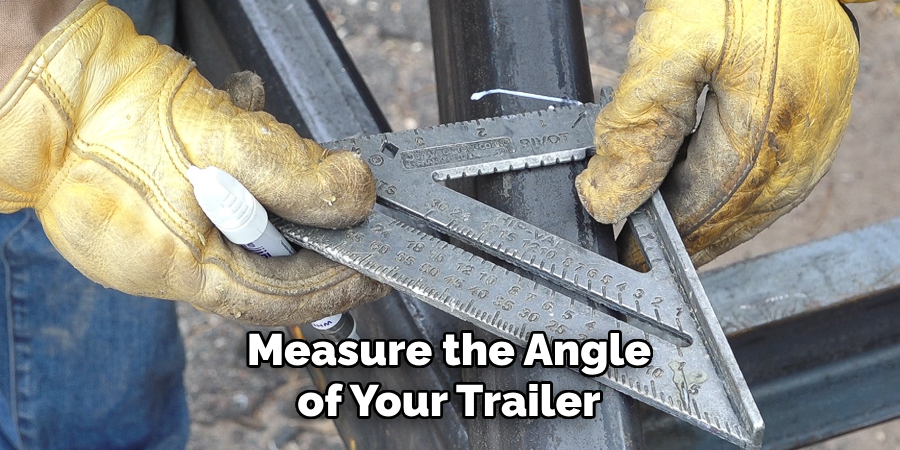
Using the leveling tool, measure the angle of your trailer. Ideally, it should be at a slight downward angle towards the hitch. If it’s too high or too low, you may need to adjust the drop hitch accordingly. For example, if your trailer is tilted upwards, you may need to use a higher drop hitch to level it out.
Step 11: Test Drive
It’s always a good idea to take a short test drive after adjusting your drop hitch. This will allow you to see how your vehicle and trailer handle together and make any necessary adjustments before hitting the road.
Step 12: Make Final Adjustments if Needed
If you notice any issues during your test drive, make necessary adjustments to the drop hitch and re-measure to ensure that it is properly set up. It’s better to spend a little extra time making sure everything is correct rather than risking unsafe towing.
Measuring drop hitch may seem like a daunting task, but it’s an essential step in safe towing. By following these steps on how to measure drop hitch and using the necessary tools, you can ensure that your vehicle and trailer are properly connected and that your towing experience is smooth and worry-free.
Remember always to double-check your measurements and choose a drop hitch with a higher weight capacity than your tongue weight for added safety.
8 Things to Avoid When Measuring Drop Hitch
1) Avoid Measuring on an Uneven Surface
As mentioned earlier, it’s essential to measure your drop hitch on a flat and level surface. Measuring on an uneven surface can result in inaccurate measurements, which can lead to improper setup and unsafe towing.
2) Don’t Forget to Include Tongue Weight in Your Calculations
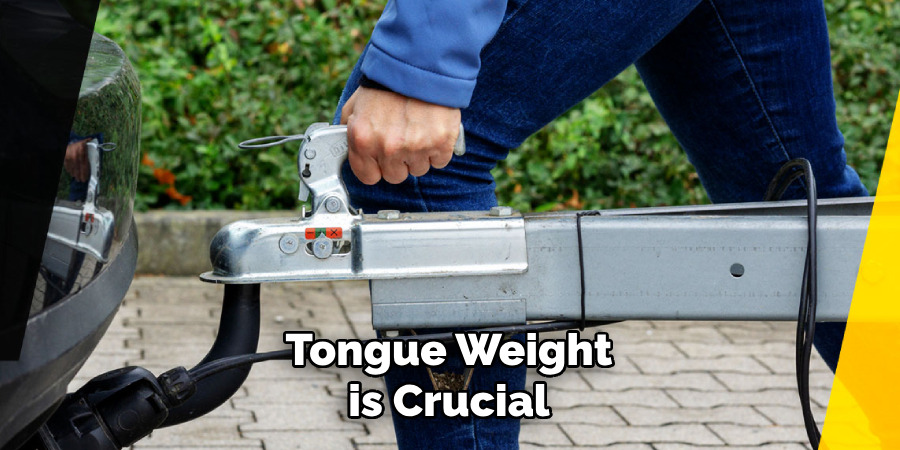
Tongue weight is crucial in selecting the right drop hitch and making necessary adjustments. Always make sure to include tongue weight in your calculations to ensure safe towing. As a rule of thumb, choose a drop hitch with a higher weight capacity than your tongue weight.
3) Avoid Choosing the Wrong Size or Capacity
Drop hitch receivers come in various sizes and capacities. It’s vital to choose the right one for your towing needs. Choosing the wrong size or capacity can result in improper setup and potentially dangerous situations while on the road.
4) Don’t Neglect to Secure Safety Latches
It is essential to connecting your trailer to the drop hitch receiver. Always make sure they are properly secured before towing to prevent any accidents or damage. While towing, it’s also a good idea to check them periodically to ensure they haven’t come loose.
5) Avoid Skipping the Test Drive
After adjusting your drop hitch and connecting your trailer, always take a short test drive. This will allow you to see how your vehicle and trailer handle together and make any necessary adjustments before hitting the road for an extended period.
6) Don’t Rely on Visual Alignment Alone
While relying on visual alignment when connecting your trailer to the drop hitch is tempting, it’s always better to use a leveling tool. This will ensure that your trailer is properly aligned and leveled for safe towing.
7) Avoid Overlooking Weight Distribution Hitch Options
If you find that your vehicle’s tongue weight exceeds its maximum towing capacity, consider using a weight distribution hitch. This type of hitch can help distribute the trailer’s weight more evenly across the vehicle, allowing for safer and more stable towing.
8) Don’t Ignore Any Issues During Test Drive
If you notice any issues while test driving, such as swaying or difficulty steering, it’s crucial to address them immediately. Don’t ignore any problems and make necessary adjustments to ensure safe towing.

By avoiding these common mistakes, you can ensure that your drop hitch is properly measured and set up for safe towing. Remember always to double-check your measurements and seek professional help if needed. With proper setup and maintenance, your drop hitch will provide a safe and worry-free towing experience.
8 Additional Tips for Measuring Drop Hitch
1) Use a Tape Measure for Accuracy
When measuring your drop hitch, using a reliable and accurate measuring tool such as a tape measure is crucial. This will ensure precise measurements and proper setup. As a general rule, always measure multiple times to ensure accuracy.
2) Consider the Type of Terrain You Will Be Towing On
The type of terrain you will be towing on can impact your drop hitch measurements. For example, if you are frequently towing on uneven or hilly roads, you may need to choose a higher drop hitch for proper leveling. Always consider the terrain when selecting a drop hitch.
3) Pay Attention to Weight Ratings
Drop hitches come with weight ratings, and it’s essential to pay attention to them. Choose a drop hitch with a higher weight rating than your tongue weight for added safety. Also, make sure that all components of the towing system, such as the vehicle, trailer, and hitch, have matching weight ratings.
4) Check Your Vehicle and Trailer’s Hitch Size
Before purchasing a drop hitch, make sure to check the sizes of both your vehicle’s hitch receiver and your trailer’s coupler. This will ensure that you select a compatible drop hitch for safe towing. For larger vehicles and trailers, you may need to consider using multiple drop hitches for proper setup.
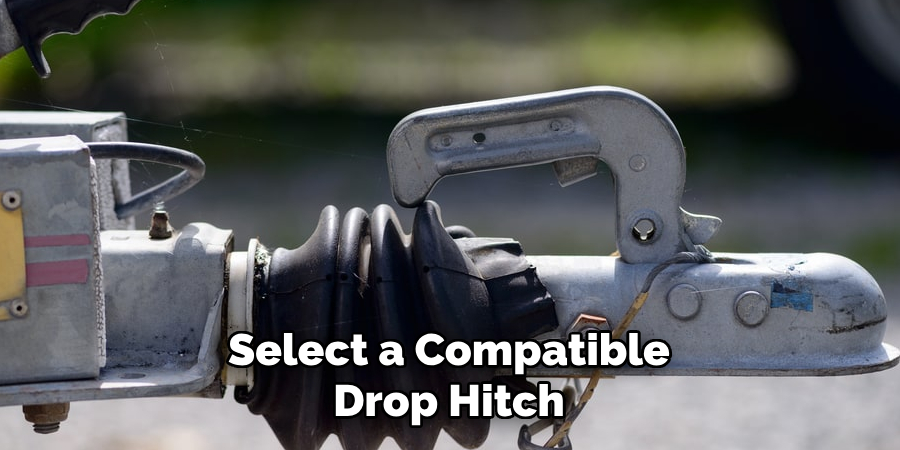
5) Use a Leveling Tool for Precision
A leveling tool such as a bubble level can greatly assist in ensuring that your trailer is level and properly aligned with the vehicle. This will help prevent swaying and other issues while towing, making for a safer driving experience.
6) Don’t Forget About Height Adjustments
Aside from the drop measurement, you may also need to make adjustments for height. This mainly applies when towing different trailers with varying coupler heights. Always measure and adjust accordingly to ensure proper setup.
7) Follow the Manufacturer’s Instructions
Every drop hitch is different, and it’s crucial to follow the manufacturer’s instructions for precise measurements and setup. If you are unsure, don’t hesitate to seek professional help or contact the manufacturer directly for assistance.
8) Regularly Maintain Your Towing System
Proper maintenance of your towing system is essential for safe towing. This includes checking and adjusting drop hitch measurements as needed, ensuring all components are secure and functioning correctly, and regularly inspecting for any signs of wear or damage. By keeping up with maintenance, you can prevent potential hazards and extend the lifespan of your towing equipment.
Overall, measuring drop hitch may seem like a simple task, but it’s essential to follow proper guidelines and avoid common mistakes for safe and efficient towing. With these tips on how to measure drop hitch in mind, you can confidently measure and set up your drop hitch for a successful towing experience.
8 Safety Measures When Using Drop Hitch
1) Always Use the Proper Size and Capacity
As mentioned earlier, using the correct drop hitch size and weight capacity is crucial for safe towing. Never exceed your vehicle’s maximum towing capacity or use a drop hitch that is not compatible with your vehicle or trailer.
2) Regularly Check for Wear and Tear
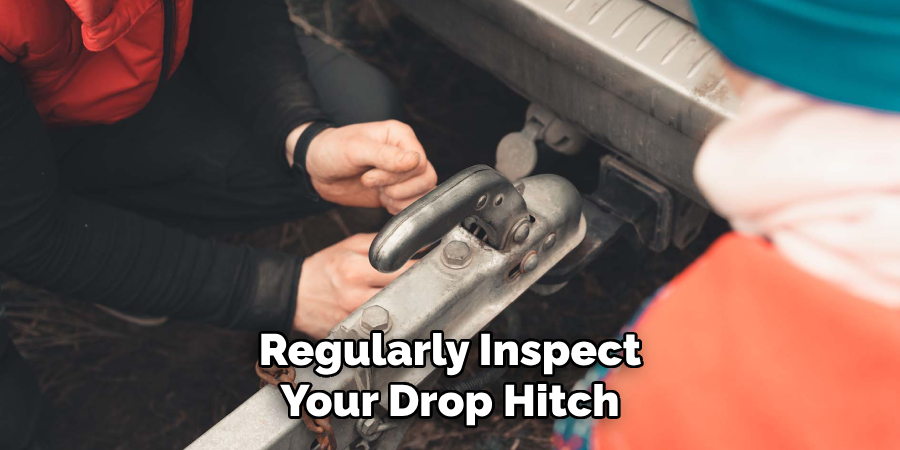
Regularly inspect your drop hitch for any signs of wear and tear, including cracks, corrosion, or bending. If you notice any damage, replace the drop hitch before towing to prevent accidents. As a general rule, it’s recommended to replace drop hitches every ten years or sooner if damage is present.
3) Secure All Components Properly
Before towing, make sure all components of your towing system are securely fastened. This includes the drop hitch, ball mount, and trailer coupler. Loose components can lead to accidents while on the road.
4) Distribute Weight Properly
Proper weight distribution is crucial for safe towing. Make sure to evenly distribute the weight of your cargo inside the trailer and keep it within the vehicle’s recommended tongue weight capacity. If necessary, use a weight-distribution hitch for added safety.
5) Use Safety Chains
Always use safety chains when towing with a drop hitch. These chains will prevent the trailer from completely separating from the vehicle in case of an accident or disconnection. So, make sure the chains are properly secured and have enough slack for turning.
6) Check Your Tires
Before towing, check your vehicle and trailer tires to ensure they are in good condition and properly inflated. This will help with stability and prevent tire blowouts while on the road. While towing, periodically check the tires for any signs of wear or damage.
7) Avoid Sudden Maneuvers
When towing with a drop hitch, avoid any sudden maneuvers such as swerving or braking abruptly. These actions can cause instability and put you at risk of losing control of your vehicle and trailer. Drive cautiously and give yourself enough time to react to any potential hazards.
8) Know Your Route
Before starting your trip, plan out your route and be aware of any potential obstacles or challenging roads. Avoid sharp turns, steep inclines, and narrow roads if possible. Knowing your route ahead of time will help you anticipate any challenges and make necessary adjustments to ensure safe towing with your drop hitch.
Properly measuring and using a drop hitch is crucial for safe and successful towing. Always pay attention to weight ratings, consider the terrain you will be towing on, and use a leveling tool for precision.
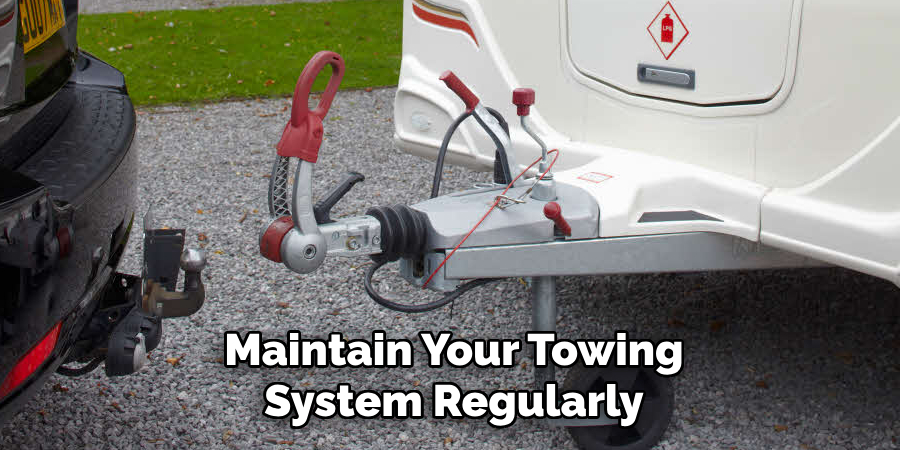
Additionally, make sure to maintain your towing system regularly and follow manufacturer instructions for precise measurements and setup. By following these steps, you can confidently tow with your drop hitch and have a safe and enjoyable towing experience.
Frequently Asked Questions about Measuring Drop Hitch
What is the Purpose of a Drop Hitch?
A drop hitch allows for proper leveling and alignment between a towing vehicle and trailer, preventing swaying and other issues while towing. It also helps distribute the trailer’s weight evenly across the vehicle, making for a safer and more comfortable driving experience.
Can I Use Any Drop Hitch on My Vehicle?
No, it’s crucial to select a drop hitch with matching weight ratings and sizes as your vehicle’s hitch receiver. Using the wrong size or capacity can result in improper setup and pose potential safety risks while towing.
How Often Should I Measure My Drop Hitch?
It’s recommended to measure your drop hitch before each towing trip, as well as periodically for regular maintenance. It’s also a good idea to check measurements if you switch trailers or make any modifications to your towing system.
What Should I Do If I Notice Issues While Towing?
If you notice issues such as swaying or difficulty steering while towing, it’s important to address them immediately. Stop and make necessary adjustments to your drop hitch measurements, or seek professional help for safe towing if needed.
Can I Measure the Drop Hitch on My Own?
Measuring drop hitch can be done on your own, but it’s always recommended to have a second person assist for more accurate measurements and safer setup.
If you are unsure or uncomfortable, it’s best to seek professional help for proper measurement and installation. Overall, measuring drop hitch is an important task that should not be taken lightly.
Conclusion
Properly measuring and setting up your drop hitch is crucial for safe and efficient towing. By avoiding common mistakes, following guidelines on how to measure drop hitch, and regularly maintaining your towing system, you can ensure a worry-free towing experience. Always prioritize safety and seek professional help if needed for accurate measurements and setup.
With these tips in mind, you can confidently hit the road with your properly measured drop hitch. So, make sure to measure carefully and enjoy your next towing adventure! Make sure always to prioritize safety and follow guidelines for a successful and enjoyable towing experience. With these tips in mind, you can confidently hit the road with your properly measured drop hitch.

About
JeepFixes Team is a skilled author for Jeep Fixes, bringing 6 years of expertise in crafting a wide range of jeep fixes. With a strong background in jeep fixes work, JeepFixes Team’s knowledge spans various types of fixtures, from decorative pieces to functional hardware, blending precision with creativity. His passion for jeep fixes and design has made him a trusted resource in the industry.
Professional Focus:
Expert in Jeep Fixes : JeepFixes Team aesthetic specializes in creating durable and innovative jeep fixes, offering both appeal and functionality. His work reflects a deep understanding of jeep fixes techniques and materials.
Sustainability Advocate : He is dedicated to using sustainable practices, ensuring that every fixture is crafted with eco-friendly methods while maintaining high-quality standards.
In his writing for jeep fixes, JeepFixes Team provides valuable insights into the latest trends, techniques, and practical advice for those passionate about jeep fixes, whether they are professionals or DIY enthusiasts. His focus on combining artistry with engineering helps others discover the true potential of jeep in design.
